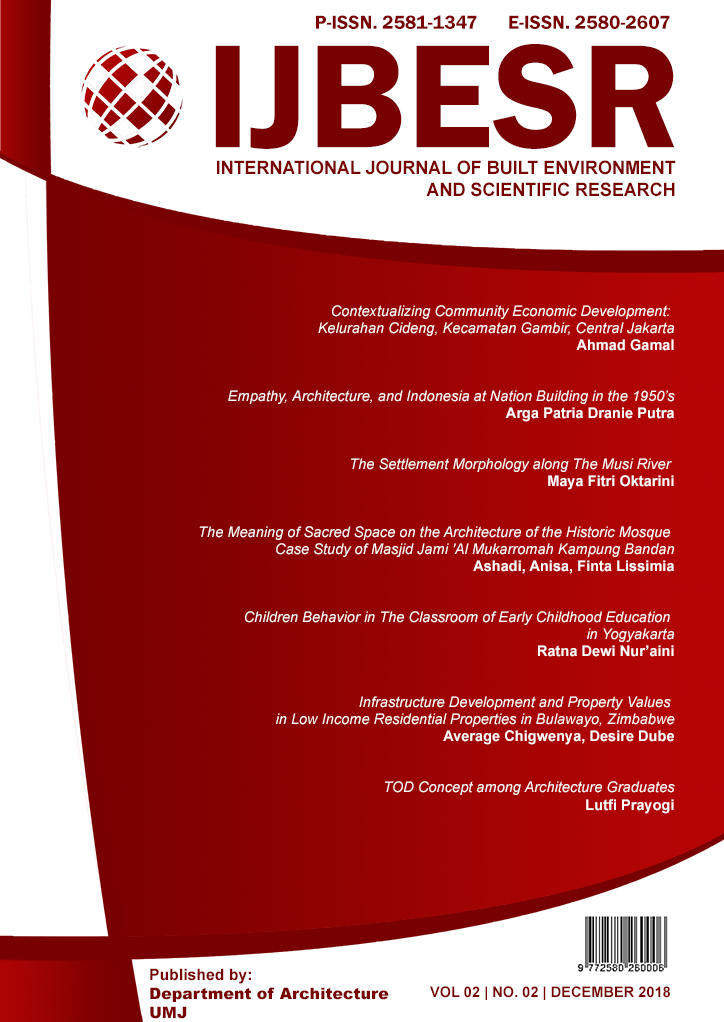The Meaning of Sacred Space on the Architecture of the Historic Mosque Case Study of Masjid Jami 'Al Mukarromah Kampung Bandan North Jakarta
DOI:
https://doi.org/10.24853/ijbesr.2.2.105-116Keywords:
sacred space, meaning, masjid Jami Al MukarromahAbstract
The building of worship is a building that has sacred spaces as a container of its activities. The case study taken in this research is the historic mosque which is often referred to as a sacred mosque because of the tomb of Habib Islamic syiar carrier. The existence of the tomb inside the mosque is what makes the mosque visited by pilgrims and pilgrims and has various activities related to worship and pilgrimage. The purpose of this research is to get a conclusion about the sacred space and its meaning in Masjid Jami 'AlMukarromah Kampung Bandan. This research uses descriptive interpretive method. Field observations were conducted by, first, observation of study subjects, ie by observing the activities undertaken at Masjid Jami 'Al Mukarromah Kampung Bandan. From activity observation can be found sacred activity and profane activity. Second, observing the spaces used sacred activities that are done in the mosque. Interviews were conducted with the main sources and direct descendants of Habib Alwi bin Ali As-Syatiri. The result of this study is that the sacred space of the Jami 'AlMukarromah mosque has a clear definition and is reflected in its physical form. The sacred space used is the main prayer room as the sacred space which has the highest hierarchy. The main prayer room is part of the expansion building. Sacred space of pilgrimage is on the part adjacent to the tomb and the original part of the mosque which is often called the Nine pillars. The area adjacent to the tomb is an important area so the expansion or renovation of the mosque does not change the original form. The sacred space used for the haul activity is the same as the sacred space for pilgrimage, that is, in the section adjacent to the tomb and pillar of nineReferences
Anisa. (2008). Studi Awal Pola Ruang Kawasan Menara Kudus. Jurnal Arsitektur NALARs Volume 7 Nomor 1 Januari 2008.
Ashadi. (2016). Makna Sinkretisme Bentuk pada Arsitektur Masjid-masjid Walisongo. Disertasi. Program Studi Doktor Arsitektur Sekolah Pascasarjana Universitas Parahyangan.
Ashadi; Anisa; Nur’aini, Ratna Dewi. (2017). Function, Form, and Meaning of Ritual and Market in Historical Site of Kampung Luar Batang Jakarta Indonesia. International Journal of Research Granthaalayah Vol. 5 (Iss.10): October 2017: 169-178.
Heuken, SJ, Adolf. (2003). Masjid-masjid tua di Jakarta. Jakarta: Yayasan Cipta Loka Caraka.
Kanumoyoso, Bondan (2011). Beyond the City Wall. Society and Economic Development in the Ommelanden of Batavia, 1684-1740. Dissertation. De Universiteit Leiden.
Makhmud, Desi Fatmala; Nurhasanah, Fitria; Utami, Indah Ulfia; Khansha, Syifa; Radnawati, Daisy; Syahadat, Ray March (2017). Mewujudkan Kampung Bandan sebagai Kampung Kota Berkelanjutan Menggunakan Pendekatan Asian New Urbanism. Vitruvian Jurnal Arsitektur, Bangunan & Lingkungan Vol. 6 No. 3 Juni 2017: 91-100.
Permana, Agus; Mawardi (2017). Habaib in Batavia in the 17th Century. A Study on the Roles of Habaib in the Process of Islamization and Islamic Preaching. Tawarih. International Journal for Historical Studies, 9 (1) October 2017: 23-32.
Rachmat Ruchiat. (2018). Asal usul nama tempat di Jakarta. (edisi revisi) Jakarta: Komunitas Bambu.
Widya, Katarina (2012). Studi Bentuk dan Elemen Arsitektur Masjid di Jakarta dari Abad 18 – Abad 20. Jurnal Comtech Vol. 3 No. 2 Desember 2012: 917-927.
Salura, Purnama, Bachtiar Fauzy, Rudy Trisno. (2015). Relasi Liturgi Dengan Ekspresi Bentuk Sakral Arsitektur Gereja Katolik. Kasus Studi : Gereja Katedral, Gereja Theresia, Gereja Salib Suci, Gereja Santo Matias Rasul,Gereja Stella Maris. Proposal Penelitian Hibah Pascasarjana. Http://Repository.Unpar.Ac.Id/Bitstream/Handle/123456789/3106/Lpd_Purnama%20salura_Relasi%20liturgi%20dengan%20ekspresi-P.Pdf?Sequence=1&Isallowed=Y
Eliade, M., 2002. The Sacred and The Profane. Cetakan pertama. Terjemahan Nurwanto.Yogyakarta: Fajar Pustaka Baru.
Jones, L., 2000. The Hermeneutics of Sacred Architecture. Cambridge, Massachussetts: Harvard University Press
Ramadhana, Dwindi dan Atyanto Dharoko. (2018). Ruang Sakral dan Profan dalam Arsitektur Masjid Agung Demak, Jawa Tengah. Jurnal INERSIA Vol XIV No 1 Mei 2018
file:///C:/Users/User/Downloads/19491-48472-1-SM.pdf
https://journal.uny.ac.id/index.php/inersia/article/view/19491
http://www.tribunnews.com/ramadan/2014/07/02/membaca-sejarah-masjid-al-mukarromah-di-kampung-bandan
http://www.beritasatu.com/destinasi/129951-melongok-makam-tertua-di-masjid-kramat-kampung-bandan.html







